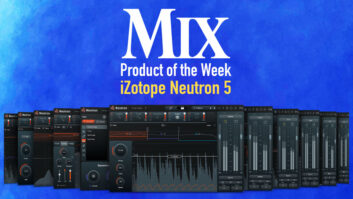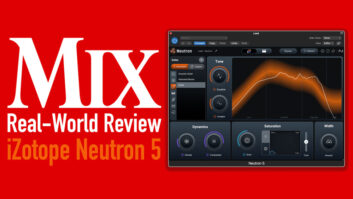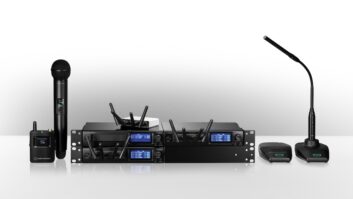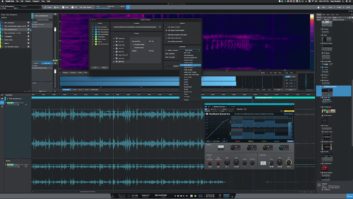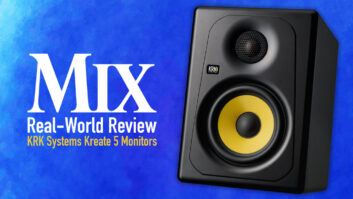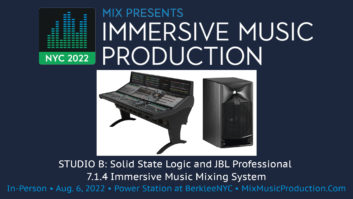Known primarily for its large-format, digitally controlled analog mixing consoles, Euphonix unveiled the System 5, its first all-digital console at the Fall ’99 AES convention. Fully equipped for 24-bit, 96kHz operation and surround mixing, the first System 5 was installed at One Union Recording in San Francisco, and there are now around 26 in operation worldwide. For this review, Mix visited Nicasio, Calif., where a System 5 was being evaluated for purchase by Skywalker Sound. [Editor’s note: The facility has since purchased two System 5s.]
We encountered a well-designed and engineered platform with impressive first-release features and silky smooth sound. Although still missing some important functions, the System 5 is clearly a product Euphonix intends to grow. Functionally, Euphonix has designed a control surface that leverages the flexibility and comprehensiveness offered by assignability while also benefiting from an intuitive, “one knob/one function” approach.
ARCHITECTUREThe most common hardware architecture for large-format digital consoles is based on three sub systems: Surface (including software), Core and I/O. The System 5 essentially fits this model, except that some control functions have been split off to an outboard computer. The hardware has been designed as a mission-critical device, with reliability, fault-tolerance and minimal downtime as primary goals. Examples of this are a backup power supply with automatic switchover facility and DSP frames that automatically switch to a spare DSP or controller card in the event of a card failure. Failed cards may be “hot swapped” and channel strips are also hot-swappable in self-enclosed “buckets.”
Rather than having everything in the system under the control of a single computer, the System 5 takes a distributed processing approach employing a number of pilot computers, a strategy intended to prevent an entire system crash because of the failure of one component. One pilot tends to the mic/line interfaces, monitor interface, machine control and MIDI. Each frame also has a pilot computer. Finally, the Studio Computer, a single-board Intel computer running Windows NT, drives a monitor (a 15-inch flat-screen comes with the system), keyboard and trackball and runs the software that configures the System 5 (Euphonix eMix). The Studio Computer also sports a CD-RW drive for data backup. (Once the system is up, the Studio Computer is not in the critical path; the system will function without it.) The pilot computers and the control surface communicate via a network switch using Euphonix’s EuCon networking scheme, a variant of 100BaseT Ethernet.
MADI is fundamental to the System 5’s audio bloodstream, running in and out of a large MADI router hub. The hub receives 28-channel 44.1 to 96kHz MADI ports from a selection of 24-bit/28-channel audio interfaces (Lightpipe, TDIF and S/PDIF audio interfaces and are slated for release this month.)
On the other side, the hub feeds the Digital Core, which comprises multiple frames containing the DSP cards, and handles all the mixing and processing. (A dedicated MADI output feeds the monitoring.) Each frame holds up to 10 active DSP cards. (One can be designated as a spare that is automatically and seamlessly brought into play if one of the others fails.) Each DSP card holds six Analog Devices SHARC chips. The frames output MADI streams that feed the router hub.
Audio moves in and out of the System 5 at 16-, 20- or 24-bit resolution; the internal signal path is 32-bit floating-point and the DSP uses 40-bit floating-point math. Euphonix recommends using the MADI-to-AES interface for sending 16- or 20-bit data to ensure that it is properly dithered.
CONFIGURATIONThe number of available channels and buses (Group, Mix and Aux) is determined by choosing a fixed configuration, called a “Mixer Model” in eMix. The eMix screen for selecting a Mixer Model clearly shows the available options and details channel, mix, bus and aux numbers and how frames are allocated in order to provide those facilities.
The choice of Mixer Models offered depends on the number of frames and DSP cards installed; the largest model available allows 226 channels. Up to 48 group (multitrack) buses, 48 mix buses and 24 aux buses are available depending on the Mixer Model. Operating at 96 kHz obviously requires more processing power than the more traditional 48/44.1 rates, so the maximum number of channels is reduced. Mixer models can be changed at any time, allowing reconfiguration from a stereo broadcast setup to a multichannel surround stem mixing environment for film.
Once a model is selected, the mix buses can be formatted into mix stems as needed. For example, a Mixer Model with 24 mix buses would accommodate four 5.1 mixes. This assignment is very easily executed from the System PC screen. One need only drag the 5.1 icon from the pop-up menu of mix stem sizes onto six unused mix buses in the matrix. The mix buses will instantly be identified as belonging to that stem, which can then be named. Auxes can be defined as mono or stereo, and complex configurations can be set up extremely quickly.
Patching is executed in another part of eMix called PatchNet. All of the channels running in and out of the Studio Hub’s I/O ports, which include interface I/O and console channels, group, mix and aux buses, appear in PatchNet and can be connected as flexibly as in a traditional analog patchbay. Patching is performed by dragging in a matrix of inputs and outputs to select and then connect. I found PatchNet both unintimidating and fast, and the simple, intuitive and powerful interface makes it easy to create complex setups very quickly on-the-fly.
CONTROL SURFACEThe control surface is available in multiple frame sizes and is laid out in the traditional fashion: X number of identical channel strips and a center section with the master facilities. No audio passes through the control surface.
Channel strips come eight to a module. Each module section has its own IP address and is connected via an Ethernet CAT 5 cable to a port of the EuCon 100BaseT switch, the other side of which goes to the pilot computers. The control computer in each module section divides the labor, avoiding the processing bottlenecks that can result when three film mixing operators share a single central computer.
Each channel strip has two signal paths, main and swap (generalized from the traditional “channel” and “monitor”), which have identical facilities and share the channel strip’s controls. Audio sources, mixes and buses can be arbitrarily mapped to the channel strips, generalizing the layer model used by many digital consoles but retaining the flexibility and space savings of a control surface with fewer channel strips than the console has audio channels. In place of layer flipping, the System 5 stores Layouts, which are simply maps of channels to strips. In essence, every layer is a custom layer, which is a powerful feature.
The controls on a strip are toggled between the inputs either locally or globally as part of a full layer change. The high-resolution channel display on the meter bridge puts graphic and status information for the currently active channel in front of the user.
Each channel strip has eight knobs of a patent-pending design. The knobs are rotary encoders with a switch operated by pressing on the top of the knob. A ring of 21 LEDs on the knob’s top displays parameter values. Typically, an arc of LEDs glowing dimly will indicate the range or excursion of the parameter while one of the LEDs will glow brightly to show the actual parameter value.
Additionally, each knob has four LEDs on top showing knob and switch automation status, and one more LED in the center that serves to color code knobs into functional groups. Next to each knob are two switches, one usually acting as an on/off and the other as a select, plus a four-character “scribble strip” display. Euphonix calls this collection of knobs, buttons and displays a “knobset.” Stylish, elegant and exquisitely functional, these knobs are one of the System 5’s true wonders. Sound like I’ve gone nuts for knobs? Just try these once and their efficiency and intuitiveness are instantly clear.
One of the pluses of a digital console is the ability to bring the functionality of any channel from an extreme end of the board to a strip in the sweet spot. Euphonix takes this one better by offering a centered channel that includes an array of 24 knobs, allowing all of a channel’s parameters to be exposed at once, eliminating the need for paging. Many engineers, possibly even most, will only ever use this “glory” channel strip, bringing whatever channel they need to work with in front of them and using the knob array.
The Strip Expand feature allows several channel strips to be used for a single channel. This makes it possible to have all parameters instantly available on several channels at once.
CHANNEL STRIP FACILITIESEach signal path has identical A and B inputs. The choice is input A, input B or sum of A+B. The selected input passes through a delay, phase reverse (with onscreen indication) and a +/-15dB trim control. On an analog console, a 30dB gain range would seem insufficient, but once a signal has been digitized, drastic gain adjustment is rarely necessary. The analog Mic Line Interface provides greater analog gain range with -12 to +72 dB, and offers a Hi-Z mode.
The standard channel display shows channel level and gain reduction metering in high resolution. An alternate mode restricts the display size for the channel to the bottom half of the display but simultaneously shows the level of the unselected channel (the “swap” channel if the “main” channel is currently active) in the top half.
Each path offers four bands of fully parametric EQ, a comprehensive dynamics section, two filters and an insert loop (which shows up in PatchNet where it can be patched to be either a digital or analog insert), which can be easily routed in any order. The arbitrariness with which these facilities can be routed is clearly a valuable utility.
The knobset is used for editing all channel parameters and is assigned by pressing the appropriate function select button (input, dynamics, EQ & filters, aux, pan) in the group found just above the fader. As each function is selected, the knobset’s first page is assigned to show the most commonly used parameters, while the presence of deeper, tweakier settings is indicated by a dim glow in one of the page forward/back buttons lying between the knobset and the function select buttons. Pressing the indicated button brings the hidden page to the knobset.
In the EQ section, a single page of eight knobs is used for the 12 parameters of the parametric bands (gain, frequency and Q) by using two knobs per band and toggling one between frequency and Q with the top “knob-side” button.
When EQ is selected, the channel display shows the EQ curve and changes it in real time as parameters are adjusted. Assigning this channel to the glory strip in the center section brings up a larger version of the EQ curve in the center display.
Meanwhile, the frequency/Q knob for each band indicates the bandwidth by the width of the arc of LEDs on the knob’s skirt, with a bright segment designating the frequency. The gain knob emulates the 7 o’clock to 5 o’clock rotation of a typical analog pot by showing an arc from 7 o’clock to the current gain setting, which is shown by the bright LED. The visual cues provided by the onscreen graphic and the LED knob skirts allow one to assess the state of the EQ at a glance.
The second EQ page controls the two filters, which can be HP, LP, notch or band types. The EQ section gain is adjustable in 11/44-dB steps, a useful facility for critical applications.
The dynamics section, consisting of a compressor and an expander/gate, is equally well implemented. The first page has the Big Four setup parameters (threshold, attack, release, ratio) for both the compressor and the expander/gate, and uses color-coded knobs for easy differentiation between compressor and expander/gate functions.
The dynamics display that comes up shows an input/output graph illustrating the dynamics settings. The “Gain Ball” (a bouncing red dot) shows the input level.
Page two has more compressor settings: knee, continuously variable between hard and soft; depth, which is the maximum allowable gain reduction; and up to 30 dB of makeup gain. Page three has more expander/gate settings (including the size of the hysteresis window), and page four contains the side-chain settings, which include a filter configurable as HP, LP, bandpass or notch. Of course, you can always have access to all functions at the same time on the glory channel.
The superb flexibility and hearty feature set of the System 5 make it a natural for surround mixing, especially post-production, and the panning section does not disappoint. With the pan section selected and the display showing the current position in an X-Y display, panning can be manipulated from the console’s trackball or by using three knobs (front L/R, front/rear and rear L/R). Personally, I prefer direct X-Y control such as provided by a trackball, or even better, a joystick. At the time of writing, no joystick is available, but film monitoring and motorized joystick panels are under development.
The panning section also includes controls for focus (the L/R pan law), divergence (leakage to other speakers), and separate send levels for the LFE channel and the other (“non-boom”) channels.
Any of the processing settings (EQ, dynamics, pan) can be easily copied and pasted to other channels, although it is not possible to copy settings to multiple destinations in one operation. Thus copying EQ settings to several vocal takes requires repeating the copy operation once for each destination track.
Up to 48 channel groups can be defined. Instead of separate group master faders, groups are mapped to strips just like channels. There are eight assignable Master faders in the center section.
THE CENTER SECTIONThe left side of the center section has eight assignable faders, the glory channel and an array of channel select buttons, which allow one to grab any channel and immediately bring it to the center.
The right side of the center section has monitoring, machine control, automation (including timecode and locator displays) and communications controls. Monitoring and machine control are discussed more completely below. The talkback mic can be selectively routed to any of the monitor mixes.
The aux, group and mix bus masters share a knobset in the center section; buttons below the knobset switch the knobs’ functions between the three.
A lot of activity will stem from the Main Panel Viewer, a display with 12 buttons running down each side and four at the bottom. Just beneath the Main Panel is a small strip display with another six buttons. A small panel lined with five buttons on either side does not yet have any function, but the Main Panel and the strip below it are heavily used for controlling master functions, such as metering, soloing, snapshots, cues and monitoring.
MONITORINGThe System 5 provides extensive monitoring facilities. There are three speaker sets available: the main set (which accommodates up to eight channels for 7.1 SDDS surround), alt 1 (up to 6 channels for 5.1), and alt 2 (2-channel stereo). CR Monitoring can be accessed in the Main Screen and any individual speaker output may be muted. Unfortunately, there is no speaker solo, so soloing must be accomplished by muting all the outputs other than the one you want to hear.
A crucial task in surround mixing is fold-down monitoring to formats with fewer channels (e.g., 5.1 to LCRS or stereo). The System 5 provides configurable fold-down between monitor formats. An input/output matrix in the eMix software allows gain to be set for the summing of each channel that is being folded down. For instance, you could specify a gain of -3 dB for the LS and RS channels when folding 5.1 down to LCRS to keep the surround channel from ending up too loud after LS and RS are folded into the mono surround. You may want to actually develop separate, tweaked mixes, which can be done simultaneously using the System 5’s mix buses. The System 5’s folddown feature will undoubtedly be useful for checking in different monitor formats while mixing, as well as for compensating for different room acoustics.
As with downmixing, bus and mix assignment and patching, sets are created in an eMix matrix with rows of devices and columns of channels. In the spirit of “waste not, want not,” any DSP not used in the currently selected mixer model is made available as additional external channels.
SNAPSHOTS & AUTOMATIONThe System 5’s got ’em both. Snapshots store the console state in whole or part, not including patching (which is stored with the Title). Any combination of automatable parameters can be selected and stored; when the snap is called, only those parameters are changed. This simplifies things like spot EQ changes or effects accents. As the System 5 is fully digital, no manual resetting is necessary; all parameters are restored as soon as the snapshot is called, and the knobs update to indicate the new values. The largest System 5 could store around 80 snapshots of all parameters, but selecting a subset of parameters can save significant amounts of memory.
The System 5’s dynamic automation is comprehensive and powerful, as almost every parameter on the console can be dynamically automated. Pairs of red and green LEDs in strategic spots on the control surface indicate the automation status of parameters. The automation panel in the center section provides dedicated buttons for most major automation functions, as well as select buttons for major sections (EQ, dynamics, auxes, etc.).
Most of your favorite automation features are implemented: join (remember last parameters selected for automation and allow them to be punched in again), glide (fade back to existing level after punch-out), and autotakeover (punch out when existing level is reached). Other functions: touch-sensitive faders (allow punch-in/out when a fader is touched/released), fader hold (don’t punch out on release) and Knob Pickup (the rough equivalent of touch-sensitivity for knobs-they punch when they are moved).
The utility automation functions are particularly well-implemented: There are five different fill modes (in which automation data is filled in automatically), including a region fill, isolation modes for channels (in which they are functional but disconnected from the automation) and, one of my favorites, Preview (in which one essentially can punch between automation and isolation, making it easy to set up and rehearse spot punches).
Another great utility, Group Coalesce, allows users to temporarily group faders, write automation to the group master, then transfer the automation to the group members’ faders and dissolve the group.
Mix passes are stored in a tree configuration that can be viewed and accessed graphically, which simplifies the process of going back to an earlier mix. There are also several functions for managing this tree, including the ability to eliminate any mixes not in the direct line from the original pass to the present.
Like most large-format systems, the System 5 automatically stores mix passes when the timecode source is stopped. Although this is a useful configuration, I often wished that I could disable this automatic store function and have a pass only be stored if I hit a Keep or Store key after the pass is stopped.
What doesn’t the System 5’s automation have? Well, at the moment there are a couple of key things missing, the biggest one being any kind of offline automation. Additionally, mix and group bus masters cannot be automated in this release.
MACHINE CONTROLThe System 5 uses Euphonix’s TT007 unit, originally developed for the CS Series consoles, for controlling external transports. The TT007 supplies Sony 9-pin (P2), TimeLine Lynx and MIDI Machine Control interfaces and supports all formats of SMPTE and MIDI timecode.
A panel provides a jog/shuttle wheel, transport control buttons, and appropriate buttons for storing, recalling and configuring. Cue points are the System 5’s locate markers, and up to 99 can be stored per title. Although they can be grabbed on-the-fly, it is a two-step process where the current timecode value is captured into a register and then assigned with the Cue button or other locate function. It would be faster if one could put the console in a single-keystroke mode where every punch of the Cue button grabs the current value and puts it in the next available Cue.
COMMENTSThe System 5 is a superb piece of design and engineering. This console left me impressed, in fact, exhilarated.
Three primary functional issues in a digital console are configuration, available facilities and access. As for configuration, the System 5 architecture emphasizes fault-tolerance, use of off-the-shelf components and scalability, and is quickly reconfigurable from software.
The System 5 offers extensive and extremely flexible facilities, with particular strength in busing, a valuable asset for film and broadcast operations.
In terms of access, the software works very hard at feeding a lot of information to the user in a form that can be comprehended and is neither overwhelming or intimidating. The control surface is the best of its type I’ve yet seen. The knobsets and, most especially, the knobs themselves are, quite simply, a brilliant stroke. From an operational standpoint, it is difficult to overstate their effectiveness and visibility in the middle of the workflow. Operation of the System 5’s features is intuitive and fast, making the system easy to learn and work on quickly.
Soundwise, the System 5 was, subjectively, clean as a whistle with an interesting and pleasing quality to it. To try to put it into the common vernacular, it was not at all “cold” and “sterile,” but the EQ didn’t quite have the fat, warm sound of a Neve or Pultec EQ. The thing that puzzled me at first listen was that I also didn’t hear it as a “neutral” sound. On the cold-to-warm scale, it sounded to me like the System 5 was a bit to the warm side of neutral, but transparent enough for surgical work.
The user interface, on the whole, is excellent. There are some rough edges that need to be smoothed out, like the inability to name hubs and potentially confusing terminology like “Device Inputs” and “Device Outputs” (How about “To Devices” and “From Devices”?), but it is a solid design.
But those rough edges were the only things I found, and I believe that Euphonix will address the most grievous of these problems quickly. This is not to say that there aren’t some big things missing from the Version 1.0 software I saw, like offline editing for the automation and stereo channels, but make no mistake, this is very much a fully-functional console.
There are many directions Euphonix could take the System 5. Intended to mate with the company’s R-1 recorder, it will be interesting to see whether some sort of hybrid mixer/workstation emerges. With a control surface this good, it would behoove Euphonix to consider leveraging it as a “HUI-ish” front-end to other workstations by adding more extensive MIDI capabilities.
Though near the top of the price range for its genre, it is hard to see the Euphonix System 5 at this moment as being anything less than the new high-water mark in large-format digital consoles.
[As Mix was going to press, Euphonix announced Version 2.0 software forthe System 5. Major new features include an on-screen diagnostic function that constantly monitors system status, providing both a confidence check and a troubleshooting tool. The System 5’s Integrated PatchNet I/O Router has been expanded to accommodate 672 by 672 sources and destinations at a sampling rate of 48 kHz (or 336 by 336 at 96 kHz). Also, some multiformat monitoring and control facilities have been added for broadcast applications.]
Euphonix, 220 Portage Ave., Palo Alto, CA 94306; 650/855-0400; fax 650/855-0410; www.euphonix.com.
